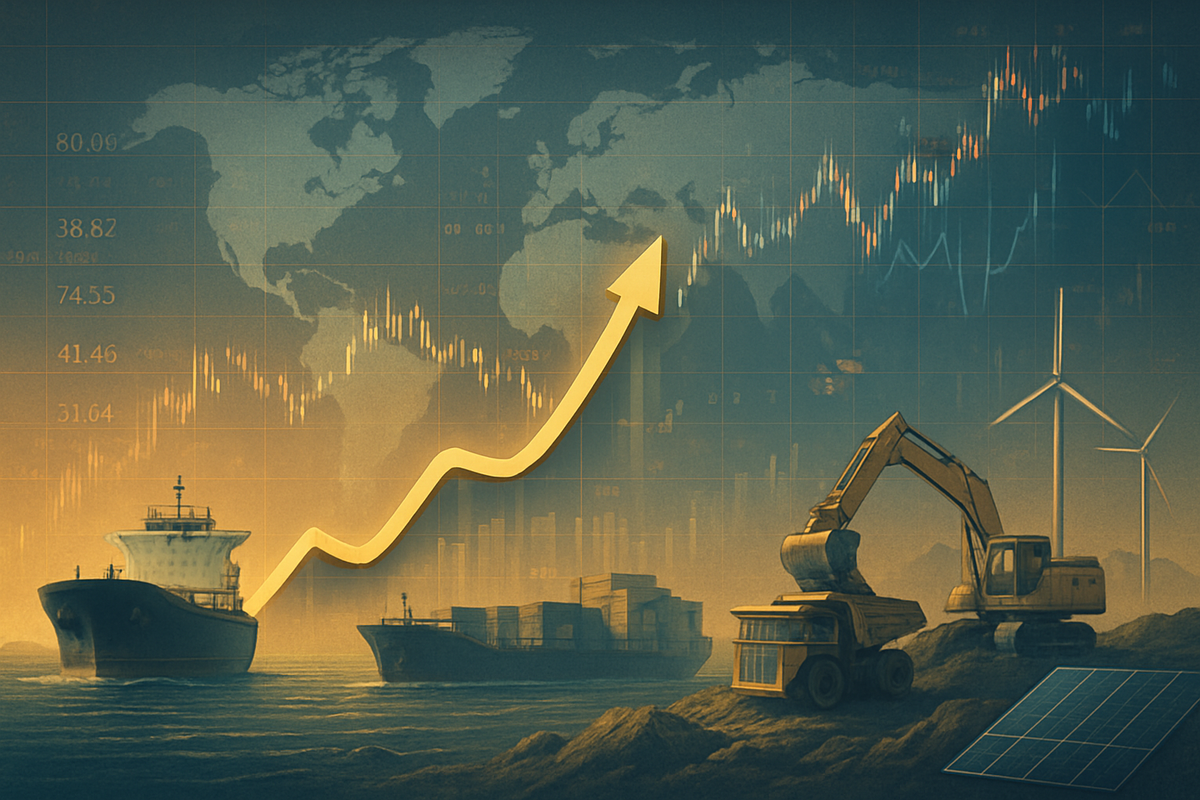
Geneva, Switzerland – November 13, 2025 – Global commodity trading giant Trafigura Group has navigated a period of extreme volatility in the global commodity markets, initially capitalizing on unprecedented price surges to report record profits in its 2023 fiscal year. This financial triumph underscored the immense opportunities presented by disrupted supply chains and geopolitical tensions, which sent prices of oil, gas, and various metals soaring. However, as markets began to normalize in 2024 and 2025, Trafigura's profits have seen a significant recalibration, demonstrating the cyclical nature of the commodity supercycle and the challenges of maintaining such elevated performance.
The company's journey through this turbulent period offers a microcosm of the broader commodity market's trajectory, highlighting how adept trading houses can thrive amidst chaos but also face the inevitable return to more stable, albeit still dynamic, conditions. Trafigura's experience provides crucial insights into the resilience required to manage immense capital flows, navigate complex logistics, and mitigate significant risks in a sector that remains profoundly influenced by global economic shifts and geopolitical events.
Navigating the Peaks and Valleys: Trafigura's Financial Journey
Trafigura Group's financial performance over the past few years vividly illustrates the dramatic swings in the global commodity market. In its fiscal year 2023, which ended on September 30, 2023, the independent commodity trader announced a staggering record net profit of USD 7.4 billion, marking a 5% increase from the previous year's already robust USD 7.03 billion. This remarkable achievement occurred despite a 23% drop in revenue to USD 244.28 billion, a figure that reflected lower average commodity prices compared to the peak but was offset by exceptional trading margins and strategic positioning. The company's equity also reached an all-time high of USD 16.5 billion, leading to a substantial payout of USD 5.92 billion to its shareholders.
The groundwork for these record profits was laid by the extreme market disruptions following the COVID-19 pandemic and, more acutely, Russia's invasion of Ukraine in early 2022. These events triggered unprecedented volatility, particularly in energy markets, with Brent crude oil prices briefly touching nearly USD 139 per barrel in March 2022. Trafigura, with its extensive network of physical assets, sophisticated logistics, and advanced risk management capabilities, was uniquely positioned to exploit the vast arbitrage opportunities that emerged from these price dislocations and help customers reconfigure supply chains.
However, the subsequent fiscal year, ending September 30, 2024, saw a significant shift. Trafigura's net profit sharply declined to USD 2.759 billion. This substantial drop was partly attributed to a USD 1.1 billion loss from a fraud discovered in its Mongolian oil business, with USD 358 million of this loss impacting the FY2024 results. While revenue remained relatively flat at USD 243.202 million due to higher trading volumes compensating for lower commodity prices, underlying earnings before interest, tax, depreciation, and amortization (EBITDA) fell by 36% to USD 8.089 billion. This signaled a clear return to more normalized market conditions after the exceptional boom period of 2022-2023. By the first half of fiscal year 2025 (ending March 31, 2025), net profit saw a slight increase to approximately USD 1.52 billion, a 3% rise from the first half of 2024, despite group revenues decreasing by 4% to USD 119.2 billion due to continued lower average commodity prices. This period demonstrated Trafigura's strategic pivot towards "profitable tonnes" and efficiency in a less favorable pricing environment.
Companies Navigating the Commodity Swell
The volatile commodity market, epitomized by Trafigura's fluctuating fortunes, creates distinct winners and losers across various sectors. Companies with direct exposure to commodity production, consumption, and trading are most profoundly affected.
Winners:
Commodity trading houses, like Trafigura Group, Vitol Group, Glencore Plc (LSE: GLEN), and Gunvor Group, are primary beneficiaries during periods of high volatility and rising prices. Their business models are designed to profit from price discrepancies, storage opportunities, and logistical arbitrage. When supply chains are disrupted and prices swing wildly, these firms leverage their global reach, infrastructure, and risk management expertise to secure significant margins. For instance, Vitol also reported record profits during the 2022-2023 commodity boom. Mining companies such as BHP Group Ltd. (ASX: BHP), Rio Tinto Plc (LSE: RIO), and Anglo American Plc (LSE: AAL), especially those producing industrial metals like copper, nickel, and iron ore, benefit immensely from elevated prices. Similarly, major oil and gas producers like Exxon Mobil Corporation (NYSE: XOM), Chevron Corporation (NYSE: CVX), and Shell Plc (LSE: SHEL) see their revenues and profits swell when crude oil and natural gas prices are high, leading to increased capital expenditure and shareholder returns. Companies involved in commodity logistics, shipping, and storage, such as AP Moller - Maersk A/S (CPH: MAERSK B) and various tanker operators, also often experience increased demand and higher rates during commodity booms, though their fortunes can be more tied to volume than price alone.
Losers:
Conversely, industries heavily reliant on commodity inputs often face significant challenges during price spikes. Manufacturing companies, particularly those in automotive, construction, and electronics, suffer from increased raw material costs, which can erode profit margins if they cannot pass these costs on to consumers. Airlines, such as United Airlines Holdings, Inc. (NASDAQ: UAL) and Delta Air Lines, Inc. (NYSE: DAL), are highly sensitive to jet fuel prices, and soaring crude oil costs can severely impact their profitability. Chemical producers, food processors, and agricultural businesses also face higher input costs for energy, fertilizers, and raw agricultural products. Furthermore, smaller commodity trading firms or those with less sophisticated risk management systems can be severely impacted by rapid price movements, leading to significant losses or even bankruptcies if they are caught on the wrong side of a trade or lack sufficient liquidity. Consumers, ultimately, bear the brunt of these higher costs through increased prices for goods and services, leading to inflationary pressures and reduced purchasing power.
Broader Implications and Market Resonance
Trafigura's journey through record profits and subsequent normalization is more than just a company-specific story; it is a bellwether for the broader global commodity market and its intricate relationship with geopolitics, economic cycles, and the ongoing energy transition. The period of unprecedented profitability for commodity traders, particularly in 2022 and 2023, underscored a broader industry trend of heightened volatility and supply chain vulnerabilities. The Russia-Ukraine conflict, in particular, exposed the fragility of global energy and food supply chains, leading to a scramble for alternative sources and creating immense arbitrage opportunities for firms with the logistical prowess and financial muscle to reroute supplies. This event served as a stark reminder that geopolitical instability remains a primary driver of commodity market turbulence.
The impressive performance of Trafigura's Gas, Power, and Renewables division, alongside the sustained demand for "energy transition" metals like copper and aluminum, highlights a significant structural shift in the commodity landscape. While traditional fossil fuels still dominate trading volumes, the accelerating global push towards decarbonization is creating new commodity supercycles for the materials essential to renewable energy infrastructure and electric vehicles. This trend is likely to reshape investment priorities, with increasing capital flowing into exploration and production of these critical minerals. Regulatory and policy implications are also profound. Governments globally are increasingly focused on energy security and critical mineral supply chain resilience, leading to potential policy interventions, strategic reserves, and trade agreements aimed at de-risking dependencies. The European Union's efforts to diversify gas supplies post-Ukraine invasion is a prime example of such policy shifts. Historically, periods of extreme commodity price volatility have often been followed by increased scrutiny of market transparency and potential manipulation, though the current environment largely points to fundamental supply-demand imbalances and geopolitical factors as primary drivers. The significant fraud loss reported by Trafigura also brings into focus the operational risks inherent in global trading and may lead to enhanced due diligence requirements from financial institutions lending to the sector.
What Lies Ahead: A Shifting Horizon
Looking ahead, the commodity market is poised for continued dynamism, albeit with a likely moderation of the extreme volatility seen in 2022-2023. In the short term, geopolitical tensions, particularly in Eastern Europe and the Middle East, will remain a critical factor influencing energy and agricultural commodity prices. Any escalation or de-escalation could trigger rapid market responses. The global economic outlook, including interest rate trajectories and inflation, will also play a significant role in shaping industrial demand for metals and energy. Trafigura, and other major trading houses, are likely to continue their strategic pivot towards optimizing margins rather than solely chasing volume, focusing on "profitable tonnes" and leveraging their logistical networks to capture niche opportunities.
In the long term, the most significant driver will be the energy transition. The demand for traditional fossil fuels is projected to gradually decline in certain sectors, while the demand for transition metals (copper, lithium, nickel, cobalt) is set to surge. This will necessitate massive investments in new mining projects and processing capabilities, creating both significant market opportunities and potential supply bottlenecks. Companies that can adapt their portfolios to these shifting demands, invest in sustainable practices, and secure long-term supply agreements for critical minerals will be well-positioned. Potential strategic pivots for commodity traders might include deeper investments in renewable energy projects, carbon credit trading, and advanced analytics for more precise market forecasting. Emerging market challenges could include increased regulatory oversight on environmental, social, and governance (ESG) factors, as well as intensified competition from state-backed entities seeking to secure national resource supplies. Scenarios could range from a relatively stable, though still volatile, market driven by structural demand shifts, to renewed periods of extreme price spikes triggered by unforeseen geopolitical events or accelerated climate-related disruptions.
Market Assessment and Investor Outlook
Trafigura Group's journey from record profits to a more normalized but still robust performance encapsulates the volatile yet often lucrative nature of global commodity trading. The key takeaway from this period is the critical importance of agility and sophisticated risk management in navigating a market profoundly influenced by external shocks. While the era of unprecedented, pandemic- and war-driven commodity price spikes has largely receded, the underlying drivers of market dynamism – geopolitical instability, evolving energy demands, and supply chain vulnerabilities – remain potent.
Moving forward, the commodity market will likely exhibit a more segmented performance. Energy commodities will remain sensitive to geopolitical events and OPEC+ decisions, while industrial and transition metals will be increasingly driven by global manufacturing activity and the pace of the green energy transition. Agricultural commodities will continue to be influenced by weather patterns and regional conflicts. Investors should recognize that commodity markets are not homogenous and require granular analysis. For those looking at public companies, diversification across different commodity exposures and a focus on companies with strong balance sheets, diversified operations, and proven risk management capabilities will be crucial. Companies actively investing in energy transition materials and technologies, as well as those with robust logistical networks, may offer compelling long-term opportunities.
In the coming months, investors should closely watch for signs of sustained global economic growth, which would underpin demand for industrial commodities. Furthermore, monitoring geopolitical developments, particularly in key energy-producing and transit regions, will be paramount. Any significant policy shifts related to climate change or trade protectionism could also have profound impacts. Finally, continued scrutiny of operational risks within trading houses, as highlighted by Trafigura's fraud incident, will be important for assessing the overall health and integrity of the commodity trading ecosystem. The market moving forward will reward foresight, adaptability, and a deep understanding of interconnected global forces.
This content is intended for informational purposes only and is not financial advice






